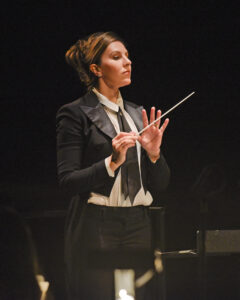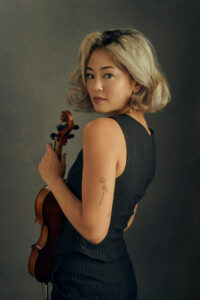At the Schermerhorn
Yankovskaya at the Nashville Symphony
Any time that it is a Music Director’s last season you must watch each guest conductor coming through with an eye towards the future. Who will take the helm after Giancarlo Guerrero? The search for a 21st century Music Director is a convoluted process with an ever-expanding list of job responsibilities. After all, what qualities does a modern Maestro possess? The musicians certainly want an affable musical partner who grows the talents of the orchestra; the audience wants someone entertaining and engaging; the marketing team must have someone to market; Metro Arts Nashville wants someone active in the community; and in Music City someone must keep the Grammys coming – just to name a few. The process is so involved, in fact, that the League of American Orchestras has published a 60 page “Music Director Search Handbook” to guide orchestras, boards, and patrons through the process. In these times, one tends to listen to visiting conductors intently, wondering if they might be a candidate.

This past weekend Lidiya Yankovskaya was the first of seven guest conductors that the Nashville Symphony is hosting for their Classical Series concerts this season. Yankovskaya is currently the Music Director of the Chicago Opera Theater, and an active symphonic guest conductor with orchestras from cities like New York, Los Angeles, Dallas, Chicago, and Atlanta on her resume. The first line of her website biography touts that she is a “fiercely committed advocate for Slavic masterpieces and contemporary works on the leading edge of classical music.” Sunday was an afternoon of interesting programming, beautiful music making, and perhaps a glimpse of what Nashville could see in the future.
The evening opened with Yankovskaya addressing the audience from the podium giving a short introduction to Missy Mazzoli’s Orpheus Undone. Yankovskaya explained that this is a piece that explored our interactions with death. I always enjoy when a conductor comes out and addresses the audience. It is a far more welcoming and contemporary approach from a conductor than simply mounting the podium and immediately putting their back towards the audience. The Orpheus myth is old and ubiquitous within the arts. The world’s first opera is about Orpheus, and many composers and artists since have retold the story in varying mediums. Orpheus Undone is Mazzoli’s longest symphonic piece, outside of opera, and opens with a woodblock tapping away a solid rhythm as the orchestra interjects punctuated chords. Eventually the pulse of the woodblock slows to a halt as the piece progresses, symbolizing the slowing heartbeat as death approaches. Cast in two large sections, the piece lasts around 15 minutes. To me the piece was largely unremarkable, but there were moments of real breathtaking orchestral textures. However, I never quite felt like it got anywhere new. It is full of very clever orchestrations, yet I was yearning for a melody to grasp onto. Perhaps like the mythical Orpheus it was not to be. The orchestra gave a faithful reading of the piece, but Orpheus Undone does not give the orchestra room to shine.

After Orpheus Undone Yankovskaya took up the microphone again to briefly talk about the next three pieces as the stage was being reset for Sergei Prokofiev’s first Violin Concerto with the fantastic Simone Porter on violin. Written during a tumultuous time in Russia, the 1917 concerto was the start of an immensely productive period for Prokofiev. This concerto has three movements and starts out timidly with a solo violin melody that is gradually taken up by the whole orchestra. Soloist Simone Porter exuded confidence and took charge throughout the performance. Her stage presence brought a new element to the work that enriched the live experience. The second movement is a firework of aggressive technicality and again Porter nailed it. The final “Moderato” movement is a great summation of the other movements, especially the first, and has the soloist serving as both accompanist and soloist at times. Porters’ tone quality throughout the piece was remarkable and credit goes to her for such an enchanting performance that afternoon. I wish her a speedy visit back to Nashville soon!
After the intermission the concert resumed with the Richard Wagner’s Liebestod from Tristan und Isolde. The Liebestod is the final eight minutes of the four-hour opera and is usually paired, on symphonic concerts, with the Prelude. This serves as a good bookend structure and is how Wagner himself premiered these excerpts back in 1862. I have never seen just the Liebestod presented without the Prelude, and it got me thinking about how frequently Wagner’s music is performed without the vocal parts. I remember quite a good performance of Guerrero leading Lorin Maazel’s arrangement of “The Ring Without Words” several years ago at the Schermerhorn. What is it about Wagner’s music that we feel it is ok to present it without one crucial element of his beloved Gesamtkunstwerk – the words? Even without the words Yankovskaya crafted an incredible journey throughout those eight minutes. It was appropriately rapturous when it needed to be, and the music seemed to be ever flowing out of the luscious Nashville string section. The performance was easily my favorite of the night. Somehow even without the words Wagner again draws us into his megalomaniacal musical vision – and it works.

The final piece on the concert was Antonín Dvořák’s 7th Symphony, written between the years of 1884 and 1885. This work is very traditional in its format with an allegro opening, adagio second movement, fast scherzo for the third, and a final allegro. Overshadowed by the 9th Symphony in terms of popularity, the 7th has found a comfortable place in the repertoire because of the formal and technical mastery that Dvořák shows. There are few examples of a symphony as well-crafted as this one. The tone of the work overall is darker than the 9th and has a gloomy mood throughout. I was most curious to see how Yankovskaya would sustain the musical line in this piece because of the larger structure and I was not disappointed. Her background in opera certainly played a role in preventing the tension of the piece from ever going slack. Each section of the orchestra blended terrifically, except for the overly strong brass in a few spots in the finale. The second movement was heartbreaking, and the third movement had tremendous lightness despite the forcefulness of the scherzo.
Overall, this concert was a intriguing mix that has me wanting more. I thought the programming was uneven in quality, but it reflected parts of Yankovskaya’s background and her versatility in the repertoire. I don’t think the Mazzoli was the best example of contemporary music, but that has more to do with the piece itself instead of the execution of it. The Nashville audience members are enthusiastic supporters of new music and will count on a steady diet of it. The Liebestod alone was an interesting change, but the playing in it was top notch. The conducting by Yankovskaya and the playing by the Nashville symphony was certainly fantastic and I hope that we get this pairing more in the future… If you would like to see the Nashville Symphony, they are back in action October 17th with Stravinsky’s The Firebird.



